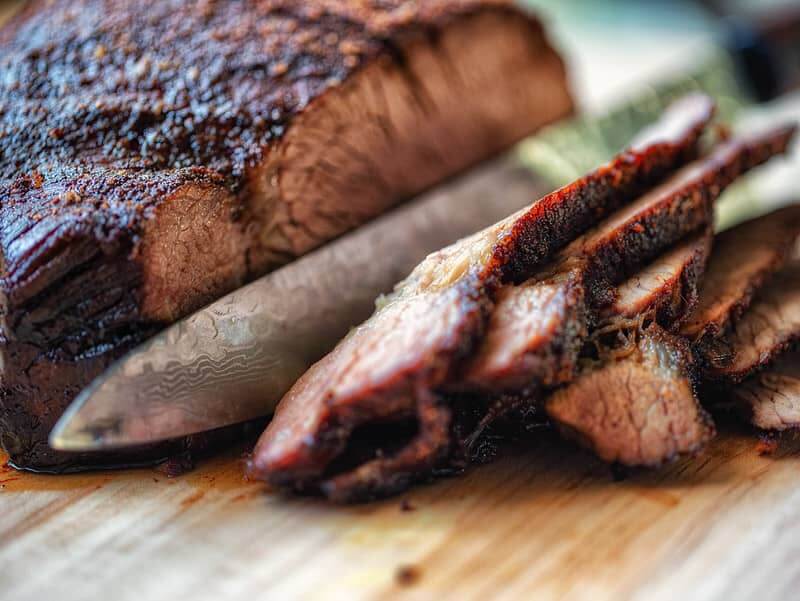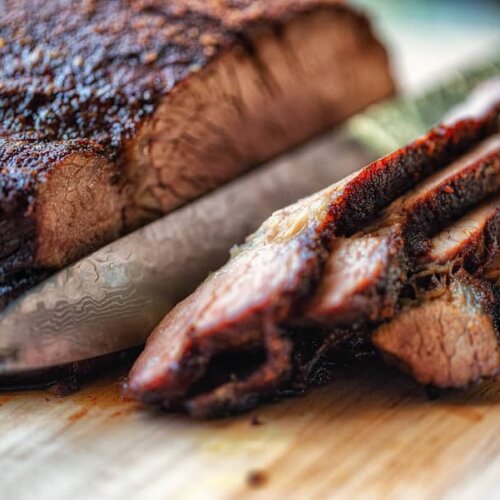
Brisket is one of those smoking recipes that’s considered a test of the pitmaster’s skills. Due to its size and somewhat uneven shape, it’s not exactly the easiest cut of beef to cook evenly on a grill or smoker. However, it’s well worth the effort once you get all the details right. If you’re familiar with your smoker and need a project to build your skills, smoking a brisket is a great way to grow. Even imperfect briskets will make great barbecue. Eventually, enough practice will leave you as skilled as the best names in the world of smoking.
Selecting a Brisket for Smoking
Good results start with a great brisket. If you choose a brisket that’s not in great shape or hasn’t been trimmed with care, you’ll end up with dry sections and uneven smoked flavor. Those with a large smoker should consider smoking an entire full brisket at once. It may weigh close to 20 lbs, but it’ll produce a juicier and more flavorful result. When you are limited to half a brisket because of smoker size or the number of diners, stick to the flat half.
Speaking of the flat end of a brisket, look for one that isn’t too thin at any point. Whether it’s a full or half brisket, you need a cut that is relatively thick and even all the way through. It’s best to buy a brisket with the fat cap intact so you can trim it yourself. If the fat is trimmed too heavily by a butcher, the exposed meat will cook less evenly.
A USDA Prime grade brisket will offer the best flavor and juiciness, even after an extended period of smoking. However, there is little reason to buy Black Angus or Wagyu beef specifically. The rich flavor and extra marbling of these cuts can actually become a little overwhelming after smoking for so long. It also doesn’t hurt that a Prime grade brisket is far more affordable than a BA or Wagyu cut.
Squeeze the brisket a little in its packaging if you can before purchasing. Softer and more pliable meat is preferred because it indicates you’ll get juicy results in the end. Make sure the meat has a deep red color and the fat is a creamy white.
Tools Needed for Smoking Brisket
You will need a meat thermometer since smoking relies on internal temperature more than time. If you’re going to handle the fat-trimming step, you’ll need a sharp filet knife. It’s thin and narrow so you can trim the fat carefully without getting too close to the muscle. You may want a pair of cooking gloves as well so you can handle the hot meat without burning your hands. Due to the size of the brisket, you need heavy-duty tongs and other grilling tools so you don’t risk dropping the meat while transferring in and out of the smoker. A large roasting pan is a good place to rest the meat when it’s done cooking as well.
To Marinate or Not to Marinate
When you marinate meat that you plan to smoke, you’re adding both flavor and moisture to the finished product. However, in return you’ll lose some of the smoky flavor and won’t get the same amount of thick bark on the exterior. For traditional brisket results, it’s best not to marinate or brine the meat before smoking.
Preparing the Brisket for Smoking
If you’ve purchased a trimmed whole brisket, all you need to do is let the meat come to room temperature and season it before it goes in the smoker. Untrimmed briskets need a little clean up before cooking. You want to leave a thin layer of fat over the meat wherever you can.
The key is to smoothly trim the fat cap on the top and bottom so there’s about ¼ to ½ inch of fat over the meat. The bottom is harder to trim, so just remove the bulk of fat and any connective tissue. The tendons that stretch around the sides and top of the roast can stay since they’ll soften up during the long smoking time.
Make sure to trim all the sides of the brisket so there’s a fresh layer of fat exposed. When trimming the top fat cap, keep the surface as smooth as possible for even cooking without burning.
The trimmed brisket is ready for seasoning. Most pitmasters recommend using a condiment like yellow mustard as a coating to keep your favorite rub stuck to the surface. Use your favorite rub made for brisket or experiment with a combination of salt, chili powder, cracked black pepper, garlic powder, cumin, and thyme.
The Question of Wrapping
You’ll have to wrap the brisket at some point during the smoking process so the interior finishes cooking without leaving the exterior too burned. You want to establish a dark, almost black layer known as the bark on the surface before wrapping.
After you wrap the brisket, no more bark can form. Some pitmasters wrap their briskets when the internal temperature is 150 degrees F to 160 degrees F. This is the point known as the “stall”, when the meat stops heating up and takes an hour or more to continue rising. It’s better to wait until the 180 degree mark if you’re a fan of well-developed bark and surface texture.
Tips for the Best Smoked Brisket
Spritzing the meat during the first stage of smoking keeps it moist and encourages the bark formation. Water works fine, but you’re missing out on the chance to add more flavor. Try a mix of apple juice, red wine vinegar, and Worcestershire sauce in your sprayer.
If you don’t want to use aluminum foil in your smoker, you can also wrap your brisket in heat-proof baking paper. Spray the paper with your spritzing liquid before wrapping the hot meat so the paper doesn’t scorch and tuck the paper under the roast when it goes in the smoker.
Recipe Variations for Smoked Brisket
Changing the rub on the brisket and experimenting with different sprays can change the finished flavor while preserving the classic brisket texture. Don’t forget different types of smoking wood that can dramatically change the results.
Best Smoked Brisket Recipe
Prepare a full-sized brisket for a crowd with this time-tested recipe. If you’re adapting it for a half brisket, make sure to reduce the total cooking time and watch the internal temperature carefully.
Ingredients
- 1 full-sized whole beef brisket, trimmed, about 12 to 18 lbs
- ½ cup of yellow mustard, olive oil, or another neutral liquid to adhere the seasonings
- ¼ cup of your favorite rub or brisket seasoning mix
- 1 teaspoon Kosher salt
- 1 teaspoon cracked black pepper
Instructions
1. Trim the brisket so there’s only a thin fat cap over the meat. Let the brisket come to room temperature, which takes about 1 hour for a full brisket or 40 minutes for a half.
2. Coat the surface of the meat, including the bottom, with the liquid you’ve chosen as an adhesive for your seasoning. Yellow mustard goes well with the flavors of the brisket, but you can also use olive oil for a more neutral base. Apply a thick coating of your chosen rub or seasoning mix, including to the bottom of the brisket.
3. Bring the smoker up to 240 to 250 degrees F. This is a higher smoking temperature than is used for most smoking recipes, but it helps push the brisket past the stalling point faster without letting it dry out. The result is a thicker bark and juicier interior with a soft but sliceable texture.
4. Place the brisket on the smoker uncovered. Let it smoke for about 2 hours, or until the internal temperature reaches 180 degrees F and you are happy with the amount of bark on the surface. Wrap the meat in butcher paper or aluminum foil, then continue smoking until the meat is 200 to 205 degrees F internally.
5. Let the meat rest for 20 minutes and serve.
Best Smoked Brisket – Nutritional Facts
Per Serving (based on 16 servings, based on a 2,000-calorie daily diet)
| Nutrient | Amount (% Daily Value (DV)) |
|---|---|
| Calories | 510 (26%) |
| Total Fat | 38g (49%) |
| Saturated Fat | 15g (75%) |
| Trans Fat | 2g |
| Cholesterol | 125mg (42%) |
| Sodium | 480mg (21%) |
| Total Carbohydrate | 1g (0%) |
| Dietary Fiber | 0g (0%) |
| Total Sugars | 0g |
| Added Sugars | 0g (0%) |
| Protein | 39g (78%) |
| Vitamin D | 0.3mcg (2%) |
| Calcium | 22mg (2%) |
| Iron | 4.1mg (23%) |
| Potassium | 610mg (13%) |
Conclusion
Despite the size, the main challenge of smoking a whole brisket is being patient and checking the temperature regularly. As long as you feel comfortable with your smoker, you should be able to create a roast that’s worthy of praise from your family and friends.

Best Smoked Brisket
Ingredients
- 12-18 lbs full-sized whole beef brisket, trimmed
- 1/2 cup yellow mustard, olive oil, or other neutral liquid to adhere the seasonings
- 1/4 cup of your favorite rub or brisket seasoning mix
- 1 tsp kosher salt
- 1 tsp cracked black pepper
Instructions
- Trim the brisket so there’s only a thin fat cap over the meat. Let the brisket come to room temperature, which takes about 1 hour for a full brisket or 40 minutes for a half.
- Coat the surface of the meat, including the bottom, with the liquid you’ve chosen as an adhesive for your seasoning. Yellow mustard goes well with the flavors of the brisket, but you can also use olive oil for a more neutral base. Apply a thick coating of your chosen rub or seasoning mix, including to the bottom of the brisket.
- Bring the smoker up to 240 to 250 degrees F. This is a higher smoking temperature than is used for most smoking recipes, but it helps push the brisket past the stalling point faster without letting it dry out. The result is a thicker bark and juicier interior with a soft but sliceable texture.
- Place the brisket on the smoker uncovered. Let it smoke for about 2 hours, or until the internal temperature reaches 180 degrees F and you are happy with the amount of bark on the surface. Wrap the meat in butcher paper or aluminum foil, then continue smoking until the meat is 200 to 205 degrees F internally.
- Let the meat rest for 20 minutes and serve.

